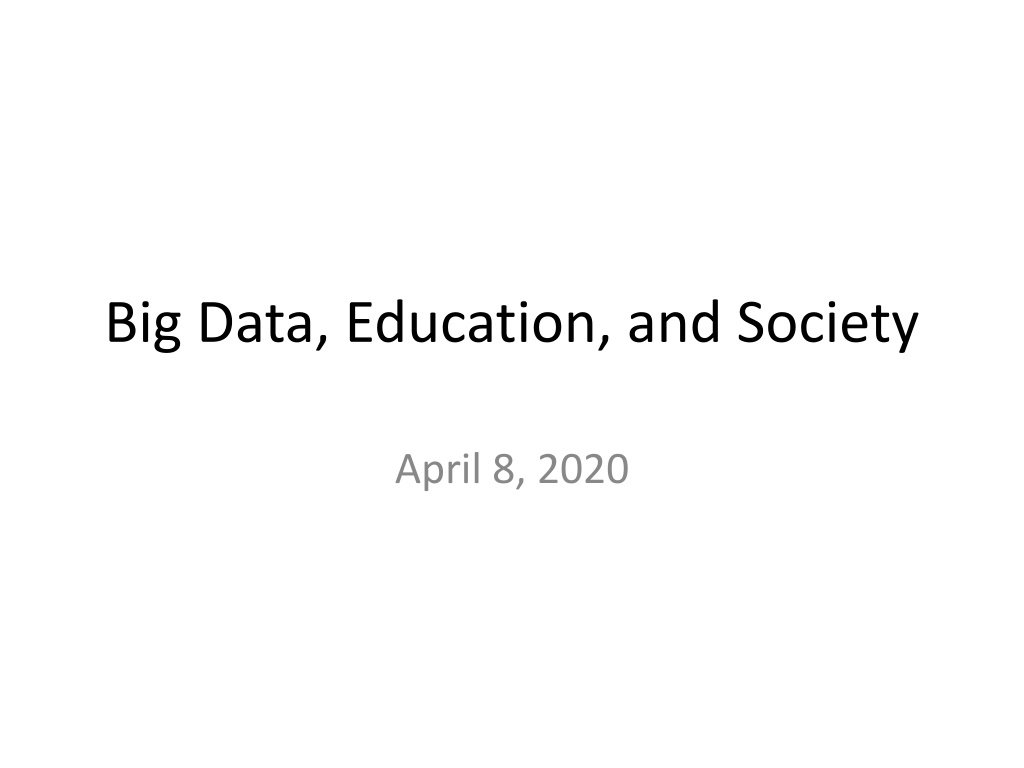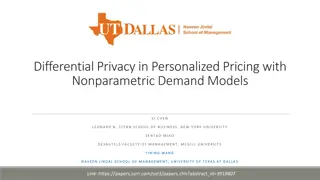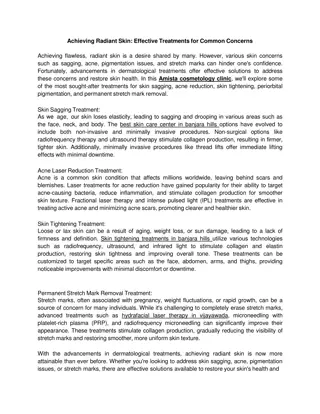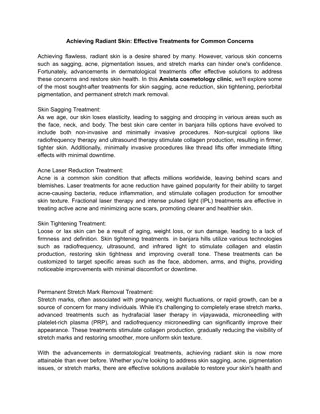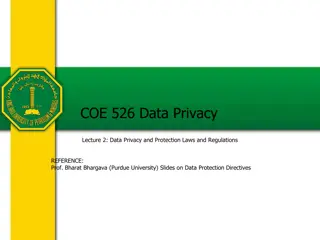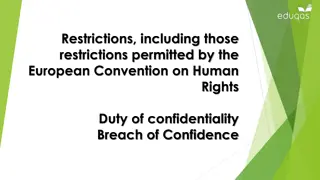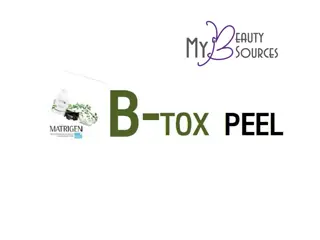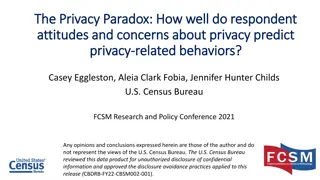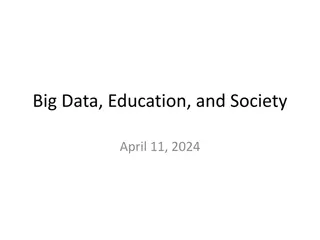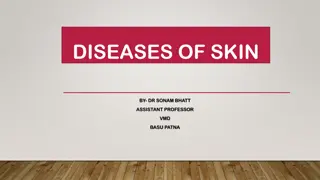Privacy Concerns Surrounding Galvanic Skin Response Bracelets in Education
The use of Galvanic Skin Response (GSR) bracelets in classrooms to measure physiological engagement has raised privacy concerns. Critics fear a dystopian future where students and teachers are monitored and controlled through electronic devices, leading to questions about common sense, funding sources, and data mining practices. These insights highlight the ethical implications of implementing such technology in educational settings.
Download Presentation

Please find below an Image/Link to download the presentation.
The content on the website is provided AS IS for your information and personal use only. It may not be sold, licensed, or shared on other websites without obtaining consent from the author. Download presentation by click this link. If you encounter any issues during the download, it is possible that the publisher has removed the file from their server.
E N D
Presentation Transcript
Big Data, Education, and Society April 8, 2020
Privacy and the Perception of Malevolence
Privacy and the Perception of Malevolence
Privacy and the Perception of Malevolence
2012 Prof. Shaundra Daily, at Clemson University, did a research trial of Galvanic Skin Response bracelets in Alabama classrooms A 1-paragraph blurb was placed on the Gates Foundation website
The Paragraph Purpose: to work with members of the Measuring Effective Teachers (MET) team to measure engagement physiologically with Galvanic Skin Response (GSR) bracelets which will determine the feasibility and utility of using such devices regularly in schools with students and teachers A basic research project studying whether engagement can be detected with GSR bracelets in schools 6
The Response (1) Gates Foundation: one more step into the dystopian future with electronic bracelets for students & teachers Put a Galvanic Skin Response (GSR) bracelet on every kid in the class and you can measure teacher effectiveness in keeping their attention. Maybe the next step is for the bracelet to zap them with electric current when their attention wanders. And then the next generation will be the Galvanic Skin Response bracelet on every teacher to zap her when she veers from the Common Core curriculum. Then. . . bring on the drones to eliminate such teachers. Leonie Haimson, NYC blogger and non-profit director 7
The Response (2) What can I say? Shades of Brave New World. Which district will be first to put the bracelets on their students and teachers? Will charter school students have to wear them, or only children in public schools? Who will pay for them? Will schools raise money by selling the data to Amazon and Google and other data-mining corporations? Have we lost all common sense? Diane Ravitch, Former U.S. Assistant Secretary of Education 8
The Response (3) Let s see now. The teacher who keeps the class in a state of high anxiety gets points on the effectiveness scale. The teacher whose students are feeling at ease in the classroom will get a low rating. If this reader saw through this flaw, why did no one at the Gates Foundation? I personally object to the Big Brother aspect of the project, as well as to the suggestion that learning can be measured by physiological reactions rather than by that yet-unmeasurable thing called understanding. This is getting to sound more like 1984 every time someone steps up to defend this unethical invasion of children s bodies. -- Diane Ravitch, Former U.S. Assistant Secretary of Education 9
The Response (3): Comments on Ravitch Blog post Bill and Melinda Gates are engaging in all kinds of scientific experiments on the little folk through their malanthropic foundation. Those criminals the Gates portray themselves as the super heroes we were waiting for to save our education system. They seem to like authoritarianism sadistic cruel environment in which people obey and fulfill their function as submissive parts in the crony capitalistic machine the Gates are running. I could see it bundled with a lithium powered cattle prod, and you ve got it. Call it the I-Prod. Let s hope it also is provides indisputable proof of the danger which undisciplined megalomaniacs like Gates pose to the evolution of mankind and highly principled civilized society. This research should be deemed immoral and illegal not handsomely rewarded. Melinda and Bill should go to jail for funding it. 10
The Response (4): Video segment on Glenn Beck show Is Big Data Big Brother? [video segment no longer available online] 11
The Response (5): Additional commentary and response Stop Common Core in Michigan Tom McMillan republican politician in Michigan; on state school board Jew World Order 12
Privacy Concerns and the Perception of Malevolence Not a right/left kind of political issue More of an extremes on both sides versus center kind of political issue
The failure of InBloom Timeline Abbreviated from https://www.studentprivacymatters.org/inblo om-timeline/ Not exactly a neutral source, but relatively factual on dates
Timeline May 2011 NYS approves no-bid contract with Wireless Generation for state educational data system, shortly after NYC school chancellor moves to WG media becomes interested July 2011 Political campaign led by Democratic and left-leaning bloggers including Leonie Haimson -- against WG contract due to Rupert Murdoch/News Corp ties and ongoing News Corp phone-hacking scandal in UK August 2011 NYS Comptroller vetoes WG contract due to News Corp ties August 2011 Gates Foundation announces Shared Learning Collaborative , a system that will recommend learning resources to students and support transmission of student data between U.S. states when a student moves to a new state for instance December 2011 NYS approves new state educational data system to be paid for by Gates Foundation; shortly after, announcement by Gates Foundation that WG will build this state data system
Timeline October 2012 Leonie Haimson holds press conference in NYC demanding details of contract, public hearing, and consent by each parent for data storage October 2012 Gates Foundation announces that parental opt-out will be allowed by platform November 2012 SLC name changes to InBloom December 2012 Gates Foundation states that each school district should decide if parents are allowed to opt-out January 2013 Louisiana, Kentucky, Georgia, North Carolina, Delaware, Illinois, Colorado, Massachusetts join InBloom
Timeline February 2013 Bloggers and activists, including Diane Ravitch, generally become interested in InBloom March 2013 Gigantic expensive party at SXSW announcing InBloom March 2013 First mainstream media coverage of InBloom
Timeline March 2013 Introduction of legislation in NY state against sharing educational data without explicit parental consent; weaker legislation allowing opt-out later approved April 2013 Louisiana withdraws from InBloom May 2014 Georgia, Delaware, Kentucky withdraw from InBloom August 2013 North Carolina withdraws from InBloom October 2013 Several NY school districts refuse state and federal funding in order to withdraw from InBloom; demand their data be deleted November 2013 InBloom client school board in Colorado lose election; Illinois and Colorado withdraw from InBloom
Timeline February 2014 New York State announces it will still share data with InBloom March 2014 NYS legislature adds amendment to state budget bill banning state from providing educational data to any company that will use data in educational dashboard April 2014 NYS withdraws from InBloom April 2014 InBloom folds after several tens of millions spent
Today Different states have different data systems many states offload data storage responsibility to individual districts and provide data standards which are broadly ignored, leading to highly inconsistent data between districts Schools use data dashboards in NY State, but at a district-by-district level
Why wasnt parental opt-out part of the original SLC/InBloom? What are the arguments for/against?
What do students think about privacy in learning applications? (Arnold & Sclater, 2017) Focus on higher ed
What do students think about privacy in learning applications? (Arnold & Sclater, 2017) i) Would you be happy for data on your learning activities to be used if it kept you from dropping out or helped you get personalized interventions? ii) Would you be happy for your data to be used if it helped improve your grades? iii) Would you be happy to have your data visualized through an app where you can look to compare with your classmates?
What do students think about privacy in learning applications?
Note The first item was not very well-designed But still Should we be withholding effective interventions from students who do not think they are worth the privacy cost? Is it ethical to provide interventions in these cases, even very gentle ones? Is it ethical to notprovide interventions in these cases?
Is deidentification a solution for research? (Khalil & Barnes, 2016) The goal of deidentification is to make it impossible to link a student back to their individual data
Is deidentification truly possible? ASSISTments twitter example
Some approaches Anonymization: removing all identifying information (but did we successfully remove it all?) De-identification: switching identifying information to a code (so the same student can still be linked within data) K-anonymization: at least K individuals must share set of pre-defined attributes for data to be released Blurring: reducing data precision or quality to minimize identification risk Changing values to range subcategories Adding noise to values Adding random data to proportion of fields
Strictly guarded key (Draschler & Geller, 2016) If there is legitimate value to being able to re-link educational data For example, to allow longitudinal follow-up on the effectiveness of an intervention Or to understand how student behavior now (or other variables) correlates to long-term outcomes Perhaps the solution is to provide the re-identification key to a trusted intermediary, with strict rules for when data can be linked This is the PSLC DataShop s approach (Koedinger et al, 2010)
Trade-offs There is a clear trade-off here, which we will return to in our discussion of beneficence Many steps to increase data security and protect privacy reduce potential benefit for students in terms of research and intervention Where is the right trade-off? Different policy and social conventions around this in different societies and for different age groups
